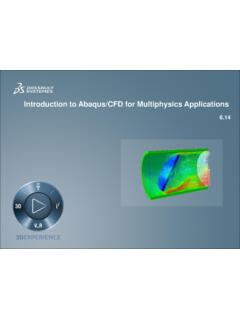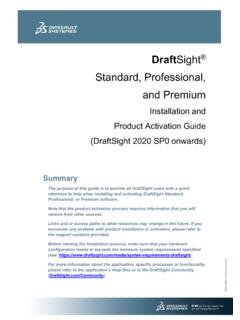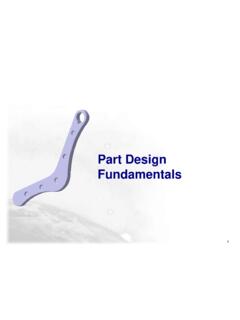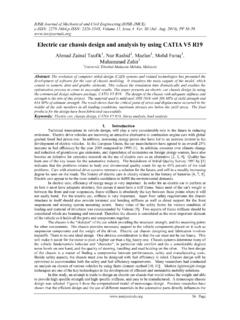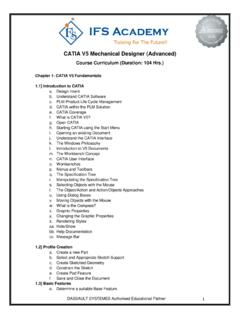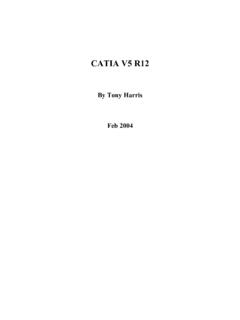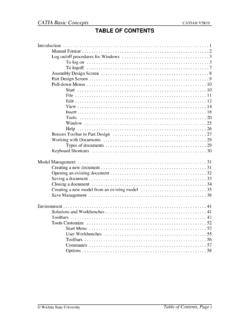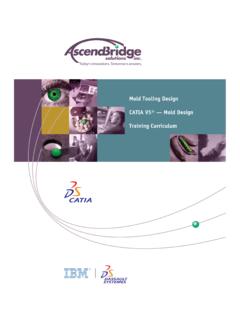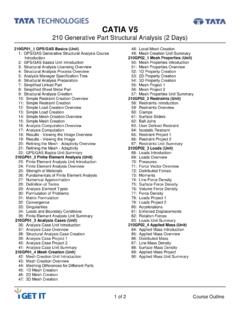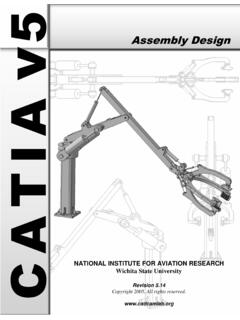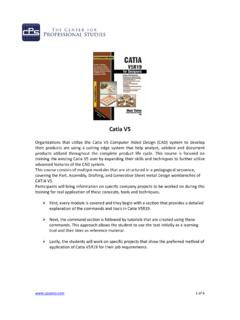Transcription of Introduction to Abaqus for CATIA V5 - 3ds.com
1 Introduction to Abaqus for CATIA V5. V5-6R2013GA. About this Course Course objectives This course covers: Integration of AFC with CATIA V5. Analysis Cases and Analysis Steps Loads, Boundary Conditions and Fields Model, Assembly and Part Properties Geometric Nonlinearity Contact Static and Thermal Analysis Results Evaluation Targeted audience This course is recommended for engineers with experience using Abaqus and CATIA V5, especially the Generative Structural Analysis workbench. Prerequisites None 2 days Day 1. Lecture 1 Abaqus for CATIA V5 Overview Lecture 2 Integration of AFC into CATIA V5. Workshop 1 Introduction to the AFC Interface Lecture 3 Analysis Cases and Analysis Steps Lecture 4 Defining Model and Part Properties Lecture 5 Defining Loads, Boundary Conditions, and Fields Workshop 2 Defining Loads, Boundary Conditions, and Fields Workshop 3 Defining a Parametric Study and an Analysis Template Workshop 4 Analysis Assembly Workshop 5 Optimization of an I-beam Day 2.
2 Lecture 6 Assembly Properties Lecture 7 Obtaining and Evaluating Results Lecture 8 Best Practices Workshop 6 Linear vs. Nonlinear - Analysis of a Skew Plate Workshop 7 Structural Analysis of an Automotive Control Arm Workshop 8 Working with Composite Shells Including Spot Welds and Contact Workshop 9 Contact Pair vs. General Contact - Lap Joint Analysis Workshop 10 Understanding Contact using an Analysis of a Syringe Workshop 11 Explicit Dynamics Analysis of a Crushable Tube Workshop 12 Thermal-Stress Analysis of a Disk Brake Workshop 13 Defining Assembly Constraints and Bolt Tightening Connections Workshop 14 Introduction to Composite Analysis Workshop 15 Steady State Dynamic Analysis of a Hood Workshop 16 Submitting a Job using the Analysis Batch Utility Workshop 17 Building and Executing a CAA Workspace Join the Community!
3 Legal Notices The Software described in this documentation is available only under license from Dassault Syst mes or its subsidiary and may be used or reproduced only in accordance with the terms of such license. This documentation and the software described in this documentation are subject to change without prior notice. Dassault Syst mes and its subsidiaries shall not be responsible for the consequences of any errors or omissions that may appear in this documentation. No part of this documentation may be reproduced or distributed in any form without prior written permission of Dassault Syst mes or its subsidiary. Dassault Syst mes, 2014. Printed in the United States of America. Abaqus , the 3DS logo, SIMULIA, and CATIA are trademarks or registered trademarks of Dassault Syst mes or its subsidiaries in the US and/or other countries.
4 Other company, product, and service names may be trademarks or service marks of their respective owners. Revision Status Lecture 1 3/14 Updated for V5-6R2013GA Workshop 1 3/14 Updated for V5-6R2013GA. Lecture 2 3/14 Updated for V5-6R2013GA Workshop 2 3/14 Updated for V5-6R2013GA. Lecture 3 3/14 Updated for V5-6R2013GA Workshop 3 3/14 Updated for V5-6R2013GA. Lecture 4 3/14 Updated for V5-6R2013GA Workshop 4 3/14 Updated for V5-6R2013GA. Lecture 5 3/14 Updated for V5-6R2013GA Workshop 5 3/14 Updated for V5-6R2013GA. Lecture 6 3/14 Updated for V5-6R2013GA Workshop 6 3/14 Updated for V5-6R2013GA. Lecture 7 3/14 Updated for V5-6R2013GA Workshop 7 3/14 Updated for V5-6R2013GA. Lecture 8 3/14 Updated for V5-6R2013GA Workshop 8 3/14 Updated for V5-6R2013GA.
5 Demonstration 1 3/14 Updated for V5-6R2013GA Workshop 9 3/14 Updated for V5-6R2013GA. Workshop 10 3/14 Updated for V5-6R2013GA. Workshop 11 3/14 Updated for V5-6R2013GA. Workshop 12 3/14 Updated for V5-6R2013GA. Workshop 13 3/14 Updated for V5-6R2013GA. Workshop 14 3/14 New for V5-6R2013GA. Workshop 15 3/14 New for V5-6R2013GA. Workshop 16 3/14 New for V5-6R2013GA. Workshop 17 3/14 New for V5-6R2013GA. Lesson 1: Abaqus for CATIA V5 Overview Lesson content: Abaqus FEA and AFC. Abaqus for CATIA V5 Features AFC-GPS Features Comparison AFC Licensing | Dassault Syst mes Linear vs. Nonlinear Analysis 30 minutes Lesson 2: Integration of AFC into CATIA V5. Lesson content: AFC Prerequisites and Co-requisites Units Material Properties Assembly Constraints | Dassault Syst mes Knowledgeware Templates and Publications Automation Job Submission Results Visualization Assembly of Analysis Product Engineering Optimizer (PEO).
6 Specification Tree Design Workshop Preliminaries Workshop 1: Introduction to the AFC Interface 2 hours Lesson 3: Analysis Cases and Analysis Steps Lesson content: What is an Analysis Case? Structure of an Analysis Case Defining an Analysis Case What is an Analysis Step? | Dassault Syst mes Structural Static Analysis Steps Structural Dynamic Analysis Step Thermal Analysis Step Step Succession Rules Step Succession Example Current Analysis Case and Step Demonstration 1. 30 minutes Lesson 4: Defining Model and Part Properties (1/2). Lesson content: Properties Overview Mesh and Model Properties Mesh Parts Material Properties | Dassault Syst mes Mesh Properties Global Element Assignment Local Element Assignment Modeling Techniques Composites Importing Composite Properties from the Composite Design Workbench XML Mapping Files for Composite Properties 45 minutes Lesson 5: Defining Loads, Boundary Conditions, and Fields Lesson content: Propagation and Activation Status Amplitudes Tabular / Smooth Step Amplitude Local Axis Systems | Dassault Syst mes User Subroutines Groups Selection Sets Nonlinear Structural Analysis Workbench Boundary Conditions, Loads, and Fields Thermal Analysis Workbench Boundary Conditions, Loads, and Fields Workshop 2.
7 Defining Loads, Boundary Conditions, and Fields Workshop 3: Defining a Parametric Study and an Analysis Template Workshop 4: Analysis Assembly Workshop 5: Optimization of an I-beam 5 hours Lesson 6: Assembly Properties (1/2). Lesson content: Assembly Properties Assembly Constraints Analysis Connections Surface Specifications | Dassault Syst mes Contact Pairs Mechanical Connection Behavior Thermal Connection Behavior More on Contact Pairs General Contact Fastened Pair Cyclic Symmetry Interaction Wizard 75 minutes Lesson 7: Obtaining and Evaluating Results (1/2). Lesson content: Tools Options Abaqus Files Output Requests Job Management Components | Dassault Syst mes Consistency Checking Job Creation Job Manager Job Monitor Storage Manager Postprocessing Tools Accessing Results Generating Images of the Results Editing Images of the Results 1 hour Lesson 8: Best Practices (1/2).
8 Lesson content: Understanding Common Warning Messages Contact Convergence Element Selection Solid Element Selection Summary | Dassault Syst mes Shell Element Selection Summary Beam Element Selection Summary 3 hours
